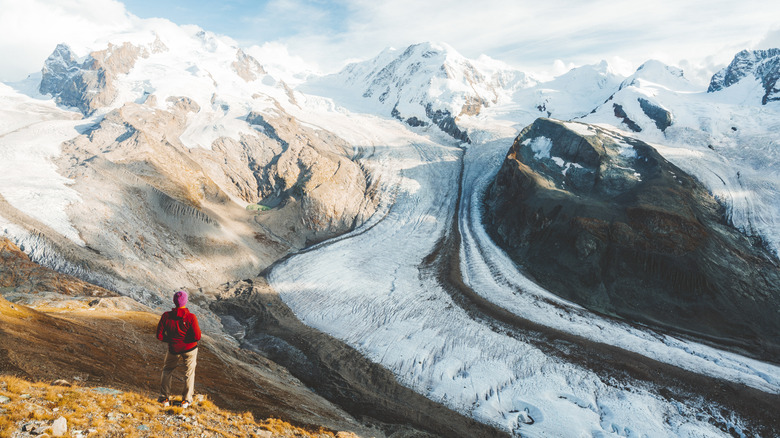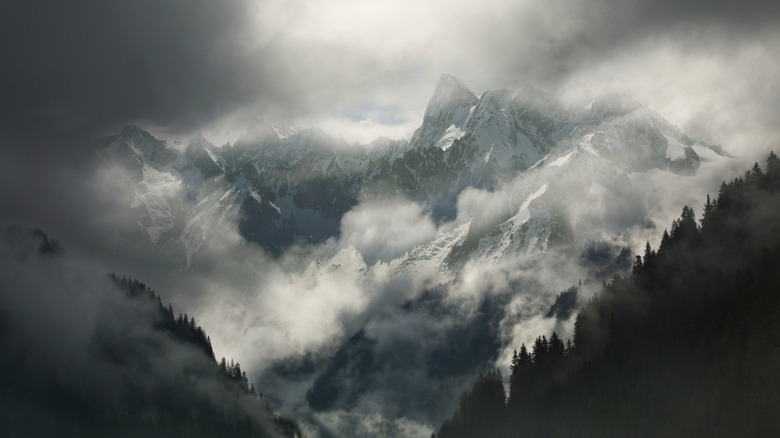The Clever Webcam Trick Tourists Hoping To Hike Switzerland's Iconic Mountains Should Know
Is it snowing in Lucerne? What is the visibility in Zermatt? Are the slopes in St. Moritz powdery, or have they frozen over, or is the snow mostly melted? These questions seems simple, but they will radically affect a vacation. Nobody wants to travel hours by train if clouds have swallowed up the Matterhorn, perhaps the most famous peak in Switzerland. Hiking the Via Alpina, one of the world's longest trails through the European Alps, is sublime on a sunny day, but do you really want to march through freezing rain? Weather can make or break your Swiss experience, especially if you love the outdoors. It would be nice to know what conditions await you — and in a worst-case scenario, at least you could change plans.
That said, the weather app on your phone may not provide a precise enough forecast to set a solid itinerary. Many Swiss residents describe the weather as wildly unpredictable; temperatures and precipitation are ever-changing and vary from one tiny hamlet to the next, especially in the Alps. In theory, you could just call the local tourism office and ask what the skies look like, but let's be honest — most of us won't do that. We want something easy and fast. Ideally, we would simply be able to see what the Swiss mountains look like at any given moment, without exerting much effort. Well, some travelers have found a way: local webcams.
Cameras have been set up in prominent locations around the world, sharing a live feed of their ambient surroundings all day, every day. Sites like Skyline Webcams or My Switzerland broadcast from numerous spots around the country, showing you exactly what you would see if you were standing on a certain overlook.
Why inclement weather is common in the Swiss Alps
Switzerland's inclement weather is due to its microclimates. The mountainous terrain traps and diverts the flow of air, varying temperature and humidity, even in two places that are geographically close together. One town may experience heavy rain and fog, while the next town over is partly cloudy and 10 degrees warmer. Meanwhile, Switzerland's sheer cliffs can rise as high as 3,000 feet above a valley floor. Different elevations will show a dramatic shift in climate. And realistically, when the Apple weather app says "rain," that could mean a lot of different things from a sprinkle to a downpour and everything in between.
That's why live webcams can be so helpful: If a picture is worth a thousand words, a live feed can determine whether a mountain hike seems feasible, or whether an expensive lift ticket is worth the price. You literally have your eyes on the prize; just short of standing in a given location, webcams provide the most visceral portrait of that place. You could be anywhere — 10 miles away, or in New Zealand — and instantly assess how sunny or grim the skies are looking.
This advice does come with some caveats: Webcams aren't everywhere, so you may not see your exact destination. These live feeds also tend to be fairly low-res, so the picture won't be crystal-clear, and just seeing a location doesn't always give a sense of what it feels like. Finally, in a country where the weather can change on a dime, the meteorology may shift from the moment you log off to the moment you actually arrive.
Webcams around the world
Still, webcams can be very useful tools, whether you're going to the Swiss Alps or any other place on the planet. If you're headed to a new destination, webcams give you a sense of how streets are laid out, how crowded they are, as well as what weather to expect. They can also just get you excited about your upcoming journey. Travel personality and European travel expert Rick Steves suggests doing research before every trip to get the most out of local culture, and live feeds provide intimate — and unadorned — glimpses of a given place. Run a search for your hometown and you'll likely find webcams operating, which may give you a whole new sense of where you live.
When it comes to weather, webcams are particularly helpful in microclimatic environments like Switzerland. In Costa Rica, for example, conditions may change in only a few miles, and whole seasons behave differently on the Pacific and Caribbean coasts. You can see the many different weather patterns across the country at Outdoor Active.
In the end, you can't control what comes out of the skies, but you can come prepared. As the old saying goes: "There's no such thing as bad weather, only bad clothes." If you're planning a trip to Switzerland and don't know what to wear, here's a guide to packing for cold weather.


